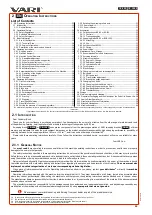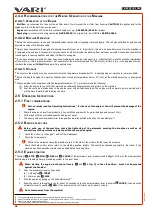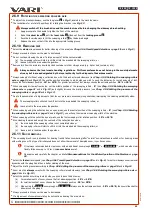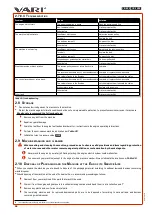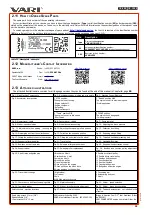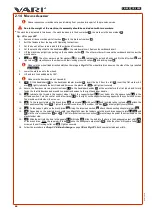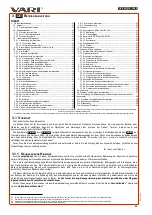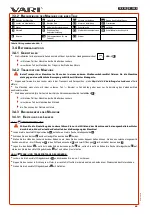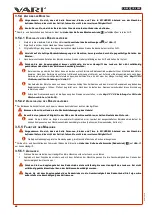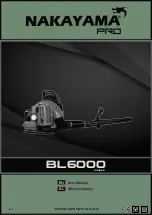
CB-800
CB-1000
4.
Remove the metal washers
4
from the brush cavity.
5.
Slide new brushes
3
onto the brush carriers
2
.
6.
Insert both metal washers
4
into the brush cavity. Screw on both M10 nuts
1
and tighten them.
7.
Adjust the bristle pressure per
Chap. 2.5.8 Setting the pressure of the sweeping rollers
on page
2.7.6 C
HANGING
THE
MACHINE
’
S
SWEEPING
WIDTH
•
The machine design allows you to change the brush sweeping width to a wider or narrower width, depending on the machine version you
have selected and purchased.
•
The current ordering numbers of brushes for both sweeping widths are available at
,
printed catalogue.
1.
Disassemble the brushes according to the procedure in
Chap. 2.7.5 Brush change
on page
(items 1 to 3 ) and in
Fig. 27
2.
Following
Fig. 32
Remove the screw connections of both fenders. Move the fenders into the holes towards/away from the
machine’s longitudinal axis
Fig. 31
3.
Fit the brushes according to the procedure in
Chap. 2.7.5 Brush change
on page
(items 4 to 7 ) and in
Fig. 27
.
4.
Move the lever extension with handle
1
during conversion to
CB-800
towards the front and during conversion to
CB-1000
towards the rear.
2.7.7 B
ELT
GEARS
•
The factory setting of the tensioning pulleys must be checked after the first approximately 5 hours of operation when the belt is breaking
in. During breaking in, it is necessary to check the function of the tensioning pulleys to prevent the tensioning pulley from being damaged
due to the extension of the belt to its damage.
•
Replace the belt if cracks or tears appear on the belt surface.
2.7.7.1 B
ELT
GEARS
TEST
If you are not sufficiently manually skilled, have this operation done by an authorised service centre.
•
If one of the following tests fails, the tensioning pulleys must be adjusted:
1.
The machine with its travel turned ON has to overcome the terrain inequality of 10 cm high - for example, a curb is suitable.
2.
A belt starts drifting (= brushes are spinning) already in the first 1/4 step of the clutch lever of the work tool drive.
Markings
A
and
B
in
Fig. 28
are common and always belong to the same Bowden.
2.7.7.2 T
RAVEL
PULLEY
ADJUSTMENT
If you are not sufficiently manually skilled, have this operation done by an authorised service centre.
1.
Remove the rear upper plastic
gearbox cover
2
(in
Fig. 7
), so you can see both belts ensuring the machine's forward travel.
Try again to overcome the terrain inequality and visually check which belt is slipping.
2.
If the belt is slipping on the right side of the machine
(
Fig. 5
Fig. 6
), tighten it by unscrewing the screw on Bowden
B
in
Fig. 28
in the direction of the arrow (away from the frame or handlebar crossbar) by 1 to two turns. Continue tensioning
until the machine overcomes some uneven terrain and simultaneously does not start moving forward when the travel clutch lever
is released. If the bolt on Bowden
B
can no longer be unscrewed, screw it in completely against the direction of the arrow and
hook the spring at the end of the cable into the far hole in the pulley arm. Then repeat the steps to tighten the belt.
3.
If the belt slips between the engine and gearbox
, tighten it with its tensioning pulley (
1
in
Fig. 28
). Release the
tensioning pulley by releasing the nut
2
located on the motor plate and tension the pulley in the direction of the arrow, using a
suitable tool (such as a screwdriver). Once tensioned, tighten the nut. Then check the correct travel operation.
As soon as you cannot adjust the tensioning pulleys, so that the belt does not slip, the belt must be replaced.
2.7.7.3 B
RUSH
DRIVE
PULLEY
ADJUSTMENT
1.
Remove the front
plastic cover
11
in
Fig. 1
, so you can see the drive belt and pulley of the brushes (
4
in
Fig. 29
).
2.
Tighten the belt by unscrewing
the screw on Bowden
A
in
Fig. 28
in the direction of the arrow (away from the frame or
handlebar crossbar) by 1 to two turns. Check the operation of the brush drive clutch. Continue tightening until the belt drive
begins to spin the brushes at approximately 1/3 of the lever travel. Simultaneously,
the belt drive must not spontaneously
when the brush drive clutch lever is switched off.
2.7.8 C
HANGING
THE
V-
BELTS
•
Replace the V-belt with a new one
every time cracks or cracks appear on the surface of the belt and also when the belt is worn
sufficiently by the operation that it can no longer be tensioned with its tensioning pulleys.
If you are not sufficiently manually skilled, have this operation done by an authorised service centre.
Observe the belt path around all the guide elements per
Fig. 29
64
Use exclusively original spare parts. If you use belts from other manufacturers, proper operation of the drive cannot be guaranteed.
36
re
vi
ze
1
2/
20
21


